NURS2007: Comparing Diabetes Monitoring Guidelines with AGREE II
VerifiedAdded on 2023/06/03
|18
|4526
|82
Report
AI Summary
This report provides a comprehensive critique of two clinical practice guidelines for diabetes monitoring: Self-Monitoring of Blood Glucose (SMBG) and Continuous Glucose Monitoring (CGM), using the AGREE II tool. It assesses the scope and purpose, stakeholder involvement, rigor of development, and clarity of presentation of both guidelines. The report highlights the advantages of CGM over SMBG, including continuous glucose level monitoring, alarms for high and low glucose levels, and suitability for studying blood sugar fluctuation trends. It also discusses the application of differences between CGM and SMBG in healthcare settings and concludes that CGM offers more comprehensive monitoring capabilities. The assessment is based on the NURS2007 assignment brief.
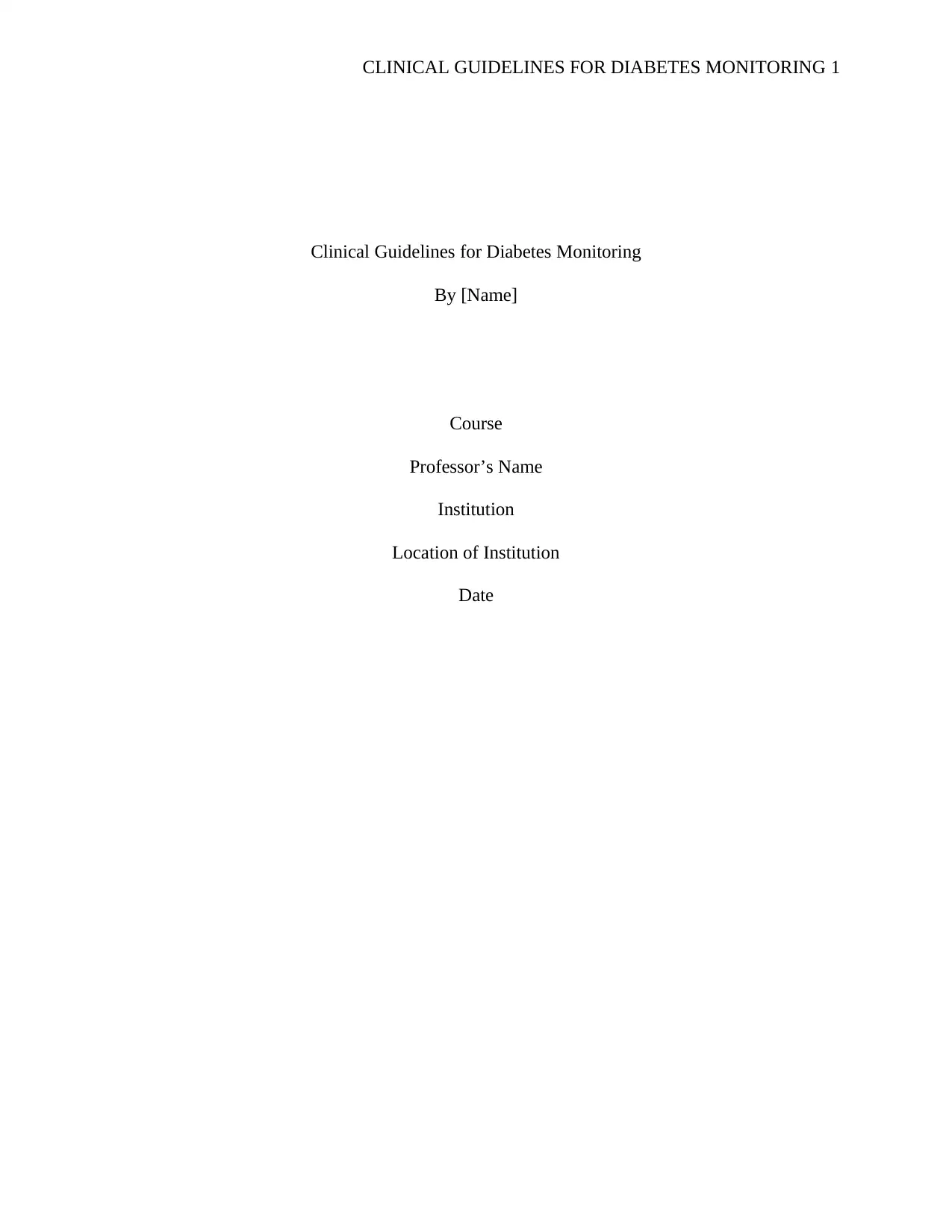
CLINICAL GUIDELINES FOR DIABETES MONITORING 1
Clinical Guidelines for Diabetes Monitoring
By [Name]
Course
Professor’s Name
Institution
Location of Institution
Date
Clinical Guidelines for Diabetes Monitoring
By [Name]
Course
Professor’s Name
Institution
Location of Institution
Date
Paraphrase This Document
Need a fresh take? Get an instant paraphrase of this document with our AI Paraphraser
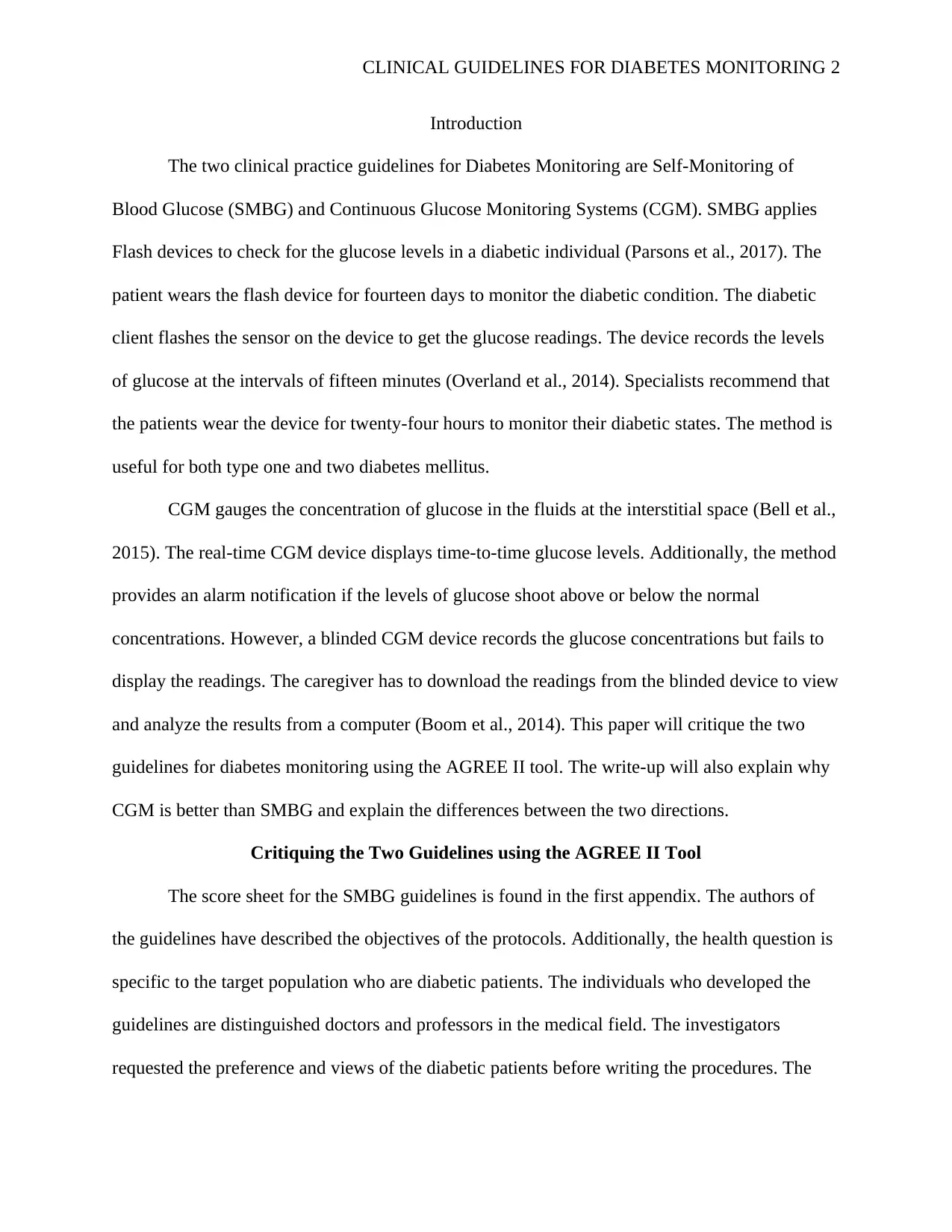
CLINICAL GUIDELINES FOR DIABETES MONITORING 2
Introduction
The two clinical practice guidelines for Diabetes Monitoring are Self-Monitoring of
Blood Glucose (SMBG) and Continuous Glucose Monitoring Systems (CGM). SMBG applies
Flash devices to check for the glucose levels in a diabetic individual (Parsons et al., 2017). The
patient wears the flash device for fourteen days to monitor the diabetic condition. The diabetic
client flashes the sensor on the device to get the glucose readings. The device records the levels
of glucose at the intervals of fifteen minutes (Overland et al., 2014). Specialists recommend that
the patients wear the device for twenty-four hours to monitor their diabetic states. The method is
useful for both type one and two diabetes mellitus.
CGM gauges the concentration of glucose in the fluids at the interstitial space (Bell et al.,
2015). The real-time CGM device displays time-to-time glucose levels. Additionally, the method
provides an alarm notification if the levels of glucose shoot above or below the normal
concentrations. However, a blinded CGM device records the glucose concentrations but fails to
display the readings. The caregiver has to download the readings from the blinded device to view
and analyze the results from a computer (Boom et al., 2014). This paper will critique the two
guidelines for diabetes monitoring using the AGREE II tool. The write-up will also explain why
CGM is better than SMBG and explain the differences between the two directions.
Critiquing the Two Guidelines using the AGREE II Tool
The score sheet for the SMBG guidelines is found in the first appendix. The authors of
the guidelines have described the objectives of the protocols. Additionally, the health question is
specific to the target population who are diabetic patients. The individuals who developed the
guidelines are distinguished doctors and professors in the medical field. The investigators
requested the preference and views of the diabetic patients before writing the procedures. The
Introduction
The two clinical practice guidelines for Diabetes Monitoring are Self-Monitoring of
Blood Glucose (SMBG) and Continuous Glucose Monitoring Systems (CGM). SMBG applies
Flash devices to check for the glucose levels in a diabetic individual (Parsons et al., 2017). The
patient wears the flash device for fourteen days to monitor the diabetic condition. The diabetic
client flashes the sensor on the device to get the glucose readings. The device records the levels
of glucose at the intervals of fifteen minutes (Overland et al., 2014). Specialists recommend that
the patients wear the device for twenty-four hours to monitor their diabetic states. The method is
useful for both type one and two diabetes mellitus.
CGM gauges the concentration of glucose in the fluids at the interstitial space (Bell et al.,
2015). The real-time CGM device displays time-to-time glucose levels. Additionally, the method
provides an alarm notification if the levels of glucose shoot above or below the normal
concentrations. However, a blinded CGM device records the glucose concentrations but fails to
display the readings. The caregiver has to download the readings from the blinded device to view
and analyze the results from a computer (Boom et al., 2014). This paper will critique the two
guidelines for diabetes monitoring using the AGREE II tool. The write-up will also explain why
CGM is better than SMBG and explain the differences between the two directions.
Critiquing the Two Guidelines using the AGREE II Tool
The score sheet for the SMBG guidelines is found in the first appendix. The authors of
the guidelines have described the objectives of the protocols. Additionally, the health question is
specific to the target population who are diabetic patients. The individuals who developed the
guidelines are distinguished doctors and professors in the medical field. The investigators
requested the preference and views of the diabetic patients before writing the procedures. The
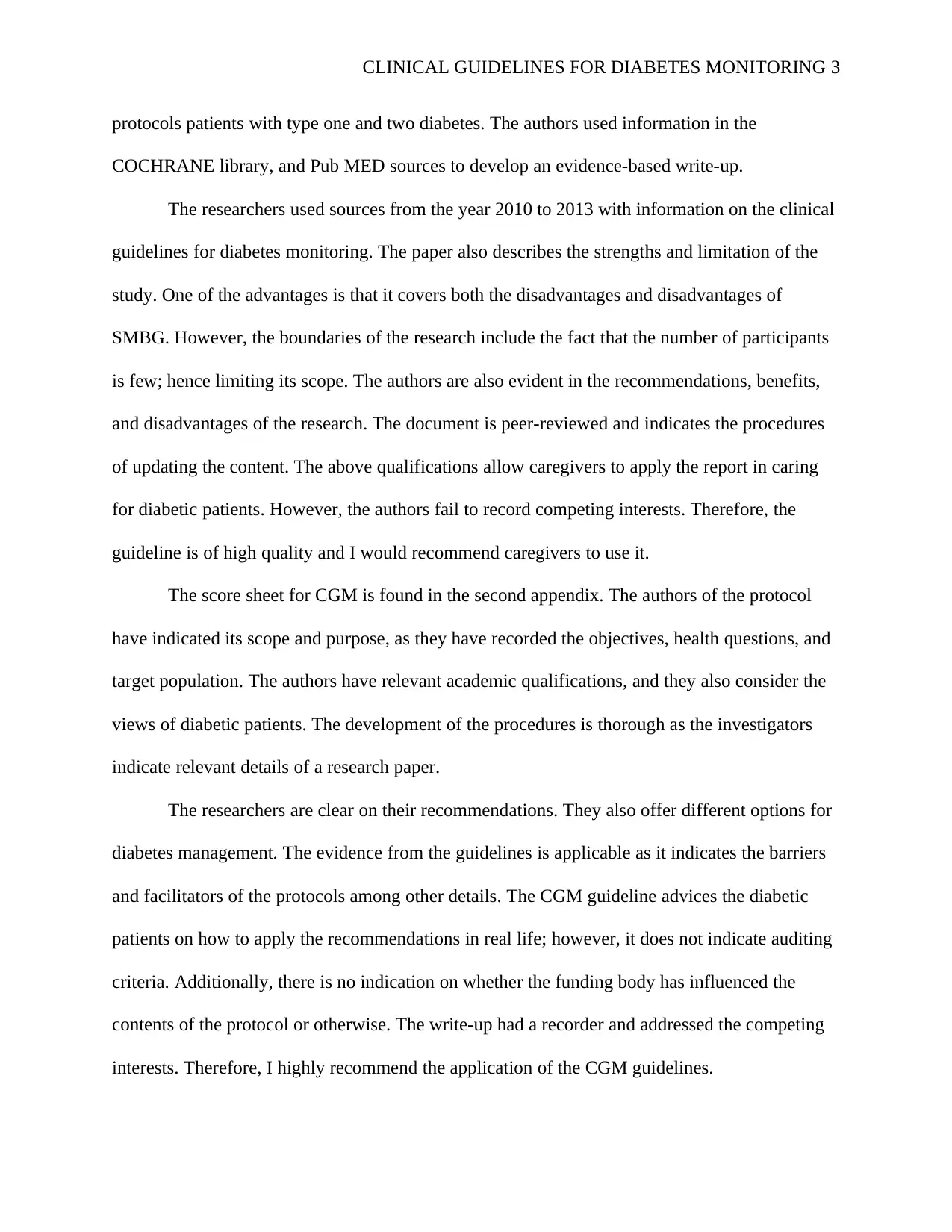
CLINICAL GUIDELINES FOR DIABETES MONITORING 3
protocols patients with type one and two diabetes. The authors used information in the
COCHRANE library, and Pub MED sources to develop an evidence-based write-up.
The researchers used sources from the year 2010 to 2013 with information on the clinical
guidelines for diabetes monitoring. The paper also describes the strengths and limitation of the
study. One of the advantages is that it covers both the disadvantages and disadvantages of
SMBG. However, the boundaries of the research include the fact that the number of participants
is few; hence limiting its scope. The authors are also evident in the recommendations, benefits,
and disadvantages of the research. The document is peer-reviewed and indicates the procedures
of updating the content. The above qualifications allow caregivers to apply the report in caring
for diabetic patients. However, the authors fail to record competing interests. Therefore, the
guideline is of high quality and I would recommend caregivers to use it.
The score sheet for CGM is found in the second appendix. The authors of the protocol
have indicated its scope and purpose, as they have recorded the objectives, health questions, and
target population. The authors have relevant academic qualifications, and they also consider the
views of diabetic patients. The development of the procedures is thorough as the investigators
indicate relevant details of a research paper.
The researchers are clear on their recommendations. They also offer different options for
diabetes management. The evidence from the guidelines is applicable as it indicates the barriers
and facilitators of the protocols among other details. The CGM guideline advices the diabetic
patients on how to apply the recommendations in real life; however, it does not indicate auditing
criteria. Additionally, there is no indication on whether the funding body has influenced the
contents of the protocol or otherwise. The write-up had a recorder and addressed the competing
interests. Therefore, I highly recommend the application of the CGM guidelines.
protocols patients with type one and two diabetes. The authors used information in the
COCHRANE library, and Pub MED sources to develop an evidence-based write-up.
The researchers used sources from the year 2010 to 2013 with information on the clinical
guidelines for diabetes monitoring. The paper also describes the strengths and limitation of the
study. One of the advantages is that it covers both the disadvantages and disadvantages of
SMBG. However, the boundaries of the research include the fact that the number of participants
is few; hence limiting its scope. The authors are also evident in the recommendations, benefits,
and disadvantages of the research. The document is peer-reviewed and indicates the procedures
of updating the content. The above qualifications allow caregivers to apply the report in caring
for diabetic patients. However, the authors fail to record competing interests. Therefore, the
guideline is of high quality and I would recommend caregivers to use it.
The score sheet for CGM is found in the second appendix. The authors of the protocol
have indicated its scope and purpose, as they have recorded the objectives, health questions, and
target population. The authors have relevant academic qualifications, and they also consider the
views of diabetic patients. The development of the procedures is thorough as the investigators
indicate relevant details of a research paper.
The researchers are clear on their recommendations. They also offer different options for
diabetes management. The evidence from the guidelines is applicable as it indicates the barriers
and facilitators of the protocols among other details. The CGM guideline advices the diabetic
patients on how to apply the recommendations in real life; however, it does not indicate auditing
criteria. Additionally, there is no indication on whether the funding body has influenced the
contents of the protocol or otherwise. The write-up had a recorder and addressed the competing
interests. Therefore, I highly recommend the application of the CGM guidelines.
⊘ This is a preview!⊘
Do you want full access?
Subscribe today to unlock all pages.

Trusted by 1+ million students worldwide
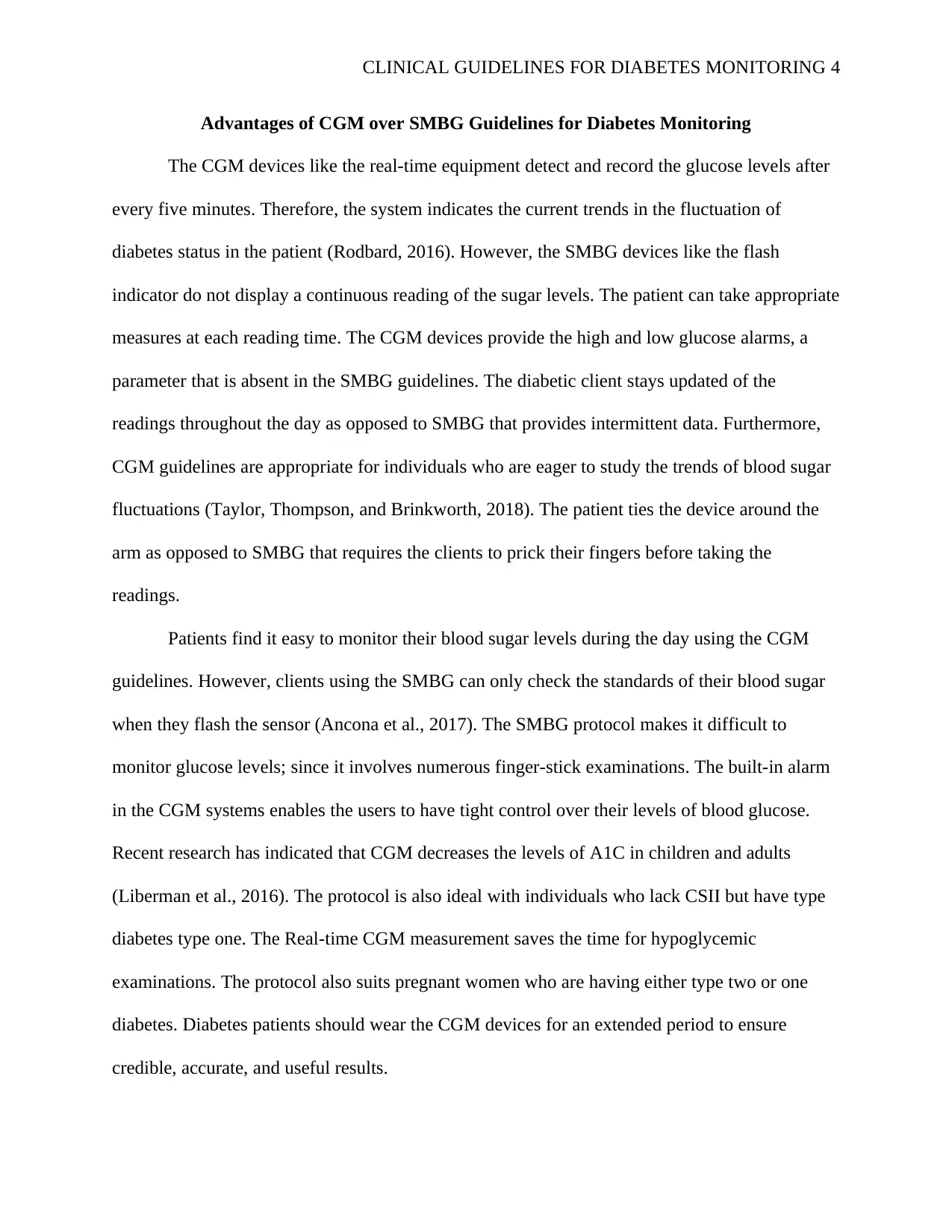
CLINICAL GUIDELINES FOR DIABETES MONITORING 4
Advantages of CGM over SMBG Guidelines for Diabetes Monitoring
The CGM devices like the real-time equipment detect and record the glucose levels after
every five minutes. Therefore, the system indicates the current trends in the fluctuation of
diabetes status in the patient (Rodbard, 2016). However, the SMBG devices like the flash
indicator do not display a continuous reading of the sugar levels. The patient can take appropriate
measures at each reading time. The CGM devices provide the high and low glucose alarms, a
parameter that is absent in the SMBG guidelines. The diabetic client stays updated of the
readings throughout the day as opposed to SMBG that provides intermittent data. Furthermore,
CGM guidelines are appropriate for individuals who are eager to study the trends of blood sugar
fluctuations (Taylor, Thompson, and Brinkworth, 2018). The patient ties the device around the
arm as opposed to SMBG that requires the clients to prick their fingers before taking the
readings.
Patients find it easy to monitor their blood sugar levels during the day using the CGM
guidelines. However, clients using the SMBG can only check the standards of their blood sugar
when they flash the sensor (Ancona et al., 2017). The SMBG protocol makes it difficult to
monitor glucose levels; since it involves numerous finger-stick examinations. The built-in alarm
in the CGM systems enables the users to have tight control over their levels of blood glucose.
Recent research has indicated that CGM decreases the levels of A1C in children and adults
(Liberman et al., 2016). The protocol is also ideal with individuals who lack CSII but have type
diabetes type one. The Real-time CGM measurement saves the time for hypoglycemic
examinations. The protocol also suits pregnant women who are having either type two or one
diabetes. Diabetes patients should wear the CGM devices for an extended period to ensure
credible, accurate, and useful results.
Advantages of CGM over SMBG Guidelines for Diabetes Monitoring
The CGM devices like the real-time equipment detect and record the glucose levels after
every five minutes. Therefore, the system indicates the current trends in the fluctuation of
diabetes status in the patient (Rodbard, 2016). However, the SMBG devices like the flash
indicator do not display a continuous reading of the sugar levels. The patient can take appropriate
measures at each reading time. The CGM devices provide the high and low glucose alarms, a
parameter that is absent in the SMBG guidelines. The diabetic client stays updated of the
readings throughout the day as opposed to SMBG that provides intermittent data. Furthermore,
CGM guidelines are appropriate for individuals who are eager to study the trends of blood sugar
fluctuations (Taylor, Thompson, and Brinkworth, 2018). The patient ties the device around the
arm as opposed to SMBG that requires the clients to prick their fingers before taking the
readings.
Patients find it easy to monitor their blood sugar levels during the day using the CGM
guidelines. However, clients using the SMBG can only check the standards of their blood sugar
when they flash the sensor (Ancona et al., 2017). The SMBG protocol makes it difficult to
monitor glucose levels; since it involves numerous finger-stick examinations. The built-in alarm
in the CGM systems enables the users to have tight control over their levels of blood glucose.
Recent research has indicated that CGM decreases the levels of A1C in children and adults
(Liberman et al., 2016). The protocol is also ideal with individuals who lack CSII but have type
diabetes type one. The Real-time CGM measurement saves the time for hypoglycemic
examinations. The protocol also suits pregnant women who are having either type two or one
diabetes. Diabetes patients should wear the CGM devices for an extended period to ensure
credible, accurate, and useful results.
Paraphrase This Document
Need a fresh take? Get an instant paraphrase of this document with our AI Paraphraser
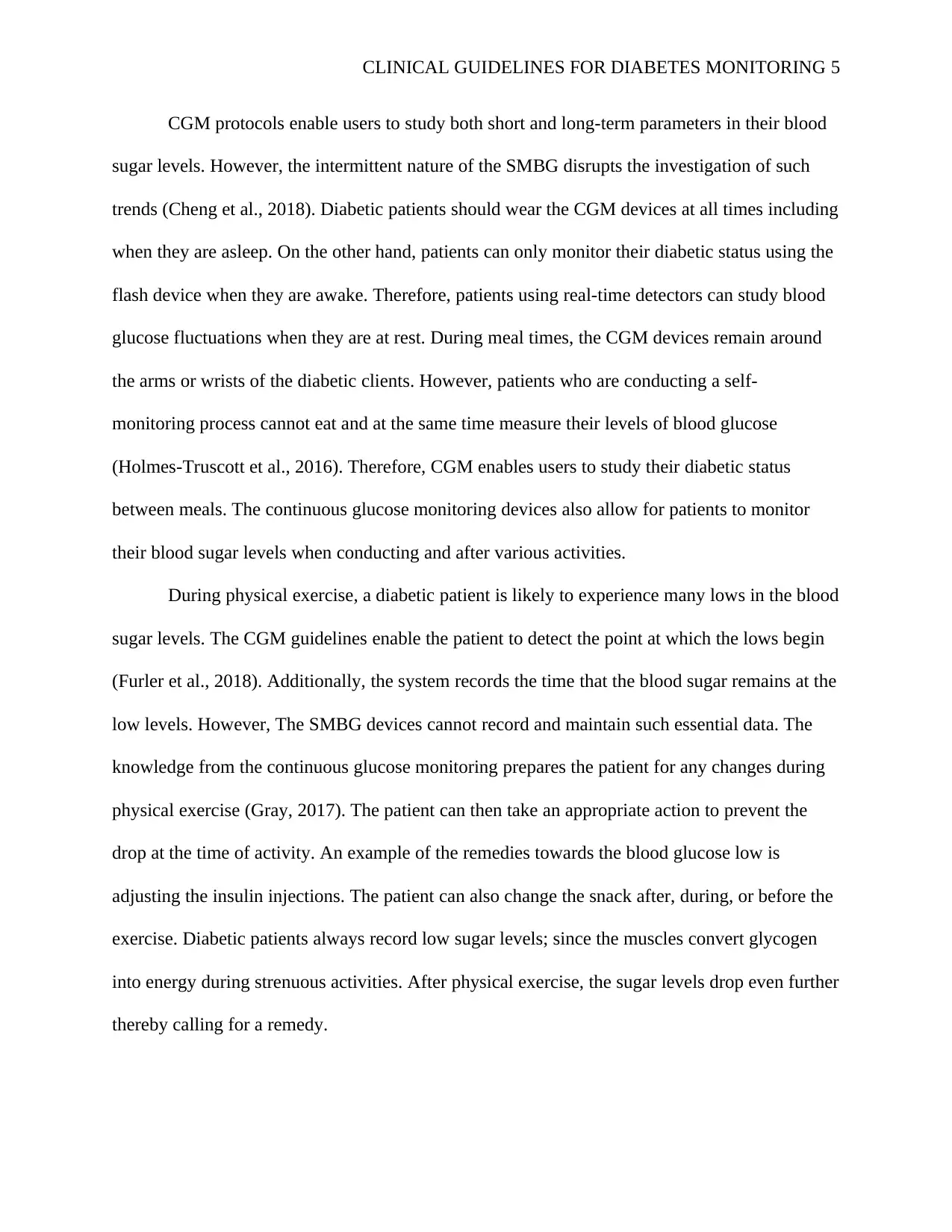
CLINICAL GUIDELINES FOR DIABETES MONITORING 5
CGM protocols enable users to study both short and long-term parameters in their blood
sugar levels. However, the intermittent nature of the SMBG disrupts the investigation of such
trends (Cheng et al., 2018). Diabetic patients should wear the CGM devices at all times including
when they are asleep. On the other hand, patients can only monitor their diabetic status using the
flash device when they are awake. Therefore, patients using real-time detectors can study blood
glucose fluctuations when they are at rest. During meal times, the CGM devices remain around
the arms or wrists of the diabetic clients. However, patients who are conducting a self-
monitoring process cannot eat and at the same time measure their levels of blood glucose
(Holmes-Truscott et al., 2016). Therefore, CGM enables users to study their diabetic status
between meals. The continuous glucose monitoring devices also allow for patients to monitor
their blood sugar levels when conducting and after various activities.
During physical exercise, a diabetic patient is likely to experience many lows in the blood
sugar levels. The CGM guidelines enable the patient to detect the point at which the lows begin
(Furler et al., 2018). Additionally, the system records the time that the blood sugar remains at the
low levels. However, The SMBG devices cannot record and maintain such essential data. The
knowledge from the continuous glucose monitoring prepares the patient for any changes during
physical exercise (Gray, 2017). The patient can then take an appropriate action to prevent the
drop at the time of activity. An example of the remedies towards the blood glucose low is
adjusting the insulin injections. The patient can also change the snack after, during, or before the
exercise. Diabetic patients always record low sugar levels; since the muscles convert glycogen
into energy during strenuous activities. After physical exercise, the sugar levels drop even further
thereby calling for a remedy.
CGM protocols enable users to study both short and long-term parameters in their blood
sugar levels. However, the intermittent nature of the SMBG disrupts the investigation of such
trends (Cheng et al., 2018). Diabetic patients should wear the CGM devices at all times including
when they are asleep. On the other hand, patients can only monitor their diabetic status using the
flash device when they are awake. Therefore, patients using real-time detectors can study blood
glucose fluctuations when they are at rest. During meal times, the CGM devices remain around
the arms or wrists of the diabetic clients. However, patients who are conducting a self-
monitoring process cannot eat and at the same time measure their levels of blood glucose
(Holmes-Truscott et al., 2016). Therefore, CGM enables users to study their diabetic status
between meals. The continuous glucose monitoring devices also allow for patients to monitor
their blood sugar levels when conducting and after various activities.
During physical exercise, a diabetic patient is likely to experience many lows in the blood
sugar levels. The CGM guidelines enable the patient to detect the point at which the lows begin
(Furler et al., 2018). Additionally, the system records the time that the blood sugar remains at the
low levels. However, The SMBG devices cannot record and maintain such essential data. The
knowledge from the continuous glucose monitoring prepares the patient for any changes during
physical exercise (Gray, 2017). The patient can then take an appropriate action to prevent the
drop at the time of activity. An example of the remedies towards the blood glucose low is
adjusting the insulin injections. The patient can also change the snack after, during, or before the
exercise. Diabetic patients always record low sugar levels; since the muscles convert glycogen
into energy during strenuous activities. After physical exercise, the sugar levels drop even further
thereby calling for a remedy.
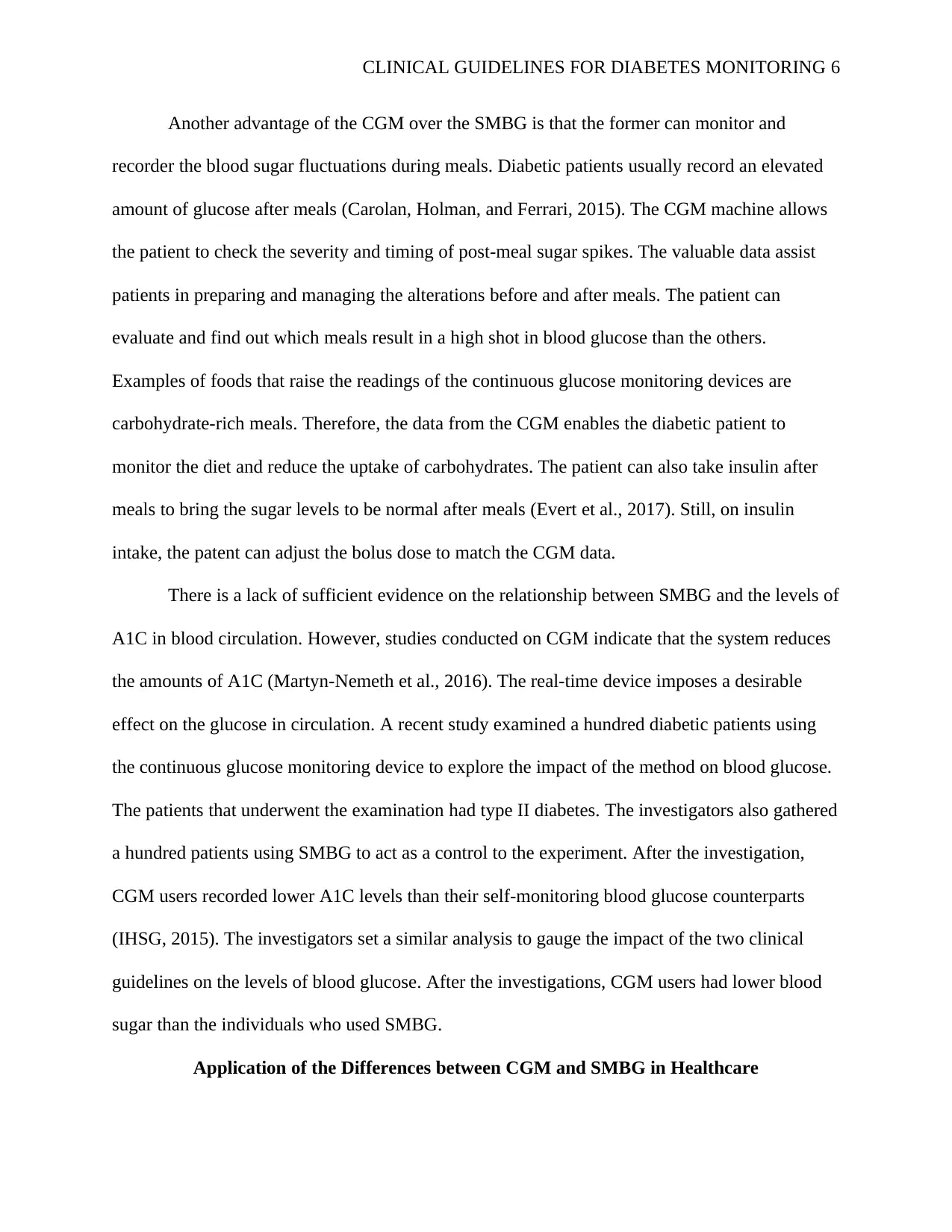
CLINICAL GUIDELINES FOR DIABETES MONITORING 6
Another advantage of the CGM over the SMBG is that the former can monitor and
recorder the blood sugar fluctuations during meals. Diabetic patients usually record an elevated
amount of glucose after meals (Carolan, Holman, and Ferrari, 2015). The CGM machine allows
the patient to check the severity and timing of post-meal sugar spikes. The valuable data assist
patients in preparing and managing the alterations before and after meals. The patient can
evaluate and find out which meals result in a high shot in blood glucose than the others.
Examples of foods that raise the readings of the continuous glucose monitoring devices are
carbohydrate-rich meals. Therefore, the data from the CGM enables the diabetic patient to
monitor the diet and reduce the uptake of carbohydrates. The patient can also take insulin after
meals to bring the sugar levels to be normal after meals (Evert et al., 2017). Still, on insulin
intake, the patent can adjust the bolus dose to match the CGM data.
There is a lack of sufficient evidence on the relationship between SMBG and the levels of
A1C in blood circulation. However, studies conducted on CGM indicate that the system reduces
the amounts of A1C (Martyn-Nemeth et al., 2016). The real-time device imposes a desirable
effect on the glucose in circulation. A recent study examined a hundred diabetic patients using
the continuous glucose monitoring device to explore the impact of the method on blood glucose.
The patients that underwent the examination had type II diabetes. The investigators also gathered
a hundred patients using SMBG to act as a control to the experiment. After the investigation,
CGM users recorded lower A1C levels than their self-monitoring blood glucose counterparts
(IHSG, 2015). The investigators set a similar analysis to gauge the impact of the two clinical
guidelines on the levels of blood glucose. After the investigations, CGM users had lower blood
sugar than the individuals who used SMBG.
Application of the Differences between CGM and SMBG in Healthcare
Another advantage of the CGM over the SMBG is that the former can monitor and
recorder the blood sugar fluctuations during meals. Diabetic patients usually record an elevated
amount of glucose after meals (Carolan, Holman, and Ferrari, 2015). The CGM machine allows
the patient to check the severity and timing of post-meal sugar spikes. The valuable data assist
patients in preparing and managing the alterations before and after meals. The patient can
evaluate and find out which meals result in a high shot in blood glucose than the others.
Examples of foods that raise the readings of the continuous glucose monitoring devices are
carbohydrate-rich meals. Therefore, the data from the CGM enables the diabetic patient to
monitor the diet and reduce the uptake of carbohydrates. The patient can also take insulin after
meals to bring the sugar levels to be normal after meals (Evert et al., 2017). Still, on insulin
intake, the patent can adjust the bolus dose to match the CGM data.
There is a lack of sufficient evidence on the relationship between SMBG and the levels of
A1C in blood circulation. However, studies conducted on CGM indicate that the system reduces
the amounts of A1C (Martyn-Nemeth et al., 2016). The real-time device imposes a desirable
effect on the glucose in circulation. A recent study examined a hundred diabetic patients using
the continuous glucose monitoring device to explore the impact of the method on blood glucose.
The patients that underwent the examination had type II diabetes. The investigators also gathered
a hundred patients using SMBG to act as a control to the experiment. After the investigation,
CGM users recorded lower A1C levels than their self-monitoring blood glucose counterparts
(IHSG, 2015). The investigators set a similar analysis to gauge the impact of the two clinical
guidelines on the levels of blood glucose. After the investigations, CGM users had lower blood
sugar than the individuals who used SMBG.
Application of the Differences between CGM and SMBG in Healthcare
⊘ This is a preview!⊘
Do you want full access?
Subscribe today to unlock all pages.

Trusted by 1+ million students worldwide
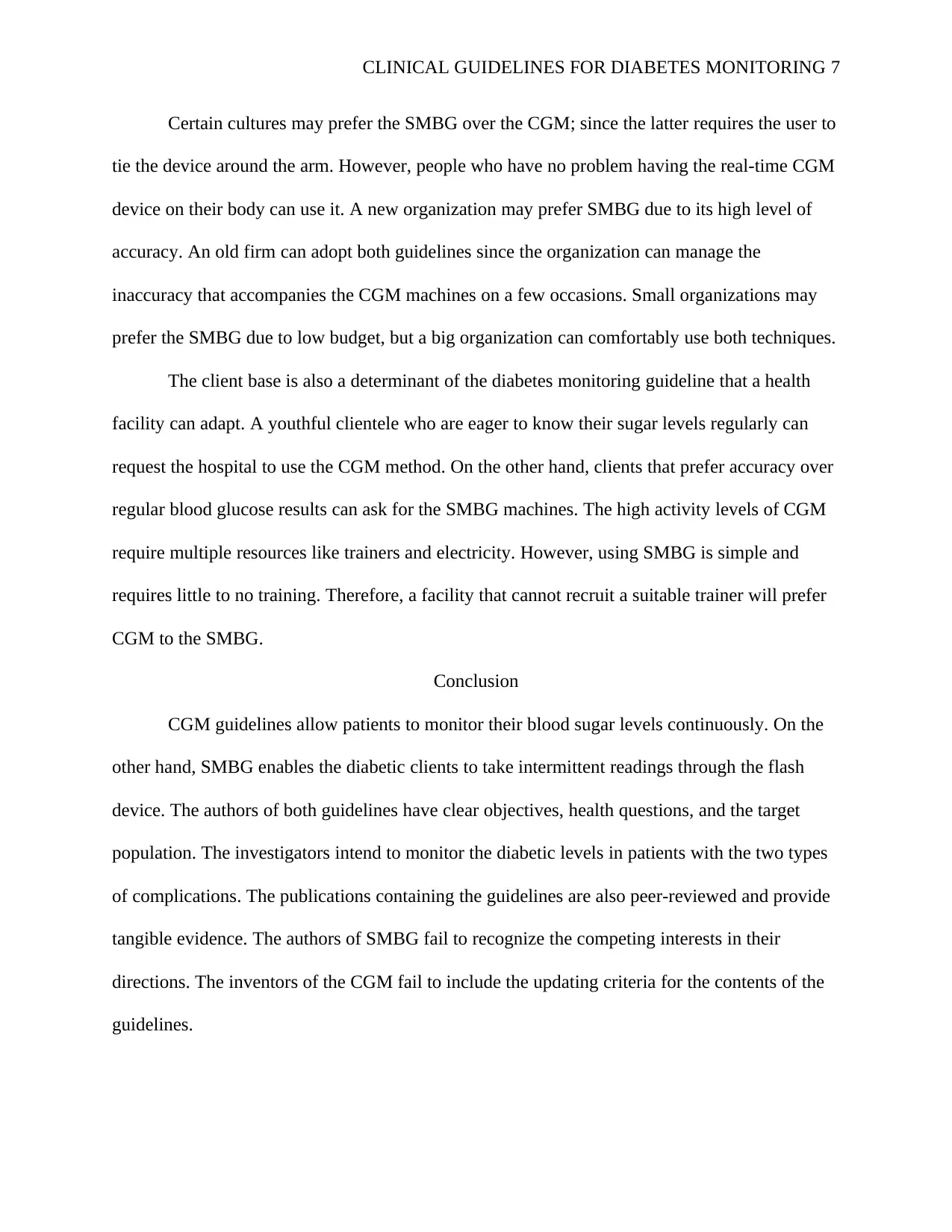
CLINICAL GUIDELINES FOR DIABETES MONITORING 7
Certain cultures may prefer the SMBG over the CGM; since the latter requires the user to
tie the device around the arm. However, people who have no problem having the real-time CGM
device on their body can use it. A new organization may prefer SMBG due to its high level of
accuracy. An old firm can adopt both guidelines since the organization can manage the
inaccuracy that accompanies the CGM machines on a few occasions. Small organizations may
prefer the SMBG due to low budget, but a big organization can comfortably use both techniques.
The client base is also a determinant of the diabetes monitoring guideline that a health
facility can adapt. A youthful clientele who are eager to know their sugar levels regularly can
request the hospital to use the CGM method. On the other hand, clients that prefer accuracy over
regular blood glucose results can ask for the SMBG machines. The high activity levels of CGM
require multiple resources like trainers and electricity. However, using SMBG is simple and
requires little to no training. Therefore, a facility that cannot recruit a suitable trainer will prefer
CGM to the SMBG.
Conclusion
CGM guidelines allow patients to monitor their blood sugar levels continuously. On the
other hand, SMBG enables the diabetic clients to take intermittent readings through the flash
device. The authors of both guidelines have clear objectives, health questions, and the target
population. The investigators intend to monitor the diabetic levels in patients with the two types
of complications. The publications containing the guidelines are also peer-reviewed and provide
tangible evidence. The authors of SMBG fail to recognize the competing interests in their
directions. The inventors of the CGM fail to include the updating criteria for the contents of the
guidelines.
Certain cultures may prefer the SMBG over the CGM; since the latter requires the user to
tie the device around the arm. However, people who have no problem having the real-time CGM
device on their body can use it. A new organization may prefer SMBG due to its high level of
accuracy. An old firm can adopt both guidelines since the organization can manage the
inaccuracy that accompanies the CGM machines on a few occasions. Small organizations may
prefer the SMBG due to low budget, but a big organization can comfortably use both techniques.
The client base is also a determinant of the diabetes monitoring guideline that a health
facility can adapt. A youthful clientele who are eager to know their sugar levels regularly can
request the hospital to use the CGM method. On the other hand, clients that prefer accuracy over
regular blood glucose results can ask for the SMBG machines. The high activity levels of CGM
require multiple resources like trainers and electricity. However, using SMBG is simple and
requires little to no training. Therefore, a facility that cannot recruit a suitable trainer will prefer
CGM to the SMBG.
Conclusion
CGM guidelines allow patients to monitor their blood sugar levels continuously. On the
other hand, SMBG enables the diabetic clients to take intermittent readings through the flash
device. The authors of both guidelines have clear objectives, health questions, and the target
population. The investigators intend to monitor the diabetic levels in patients with the two types
of complications. The publications containing the guidelines are also peer-reviewed and provide
tangible evidence. The authors of SMBG fail to recognize the competing interests in their
directions. The inventors of the CGM fail to include the updating criteria for the contents of the
guidelines.
Paraphrase This Document
Need a fresh take? Get an instant paraphrase of this document with our AI Paraphraser
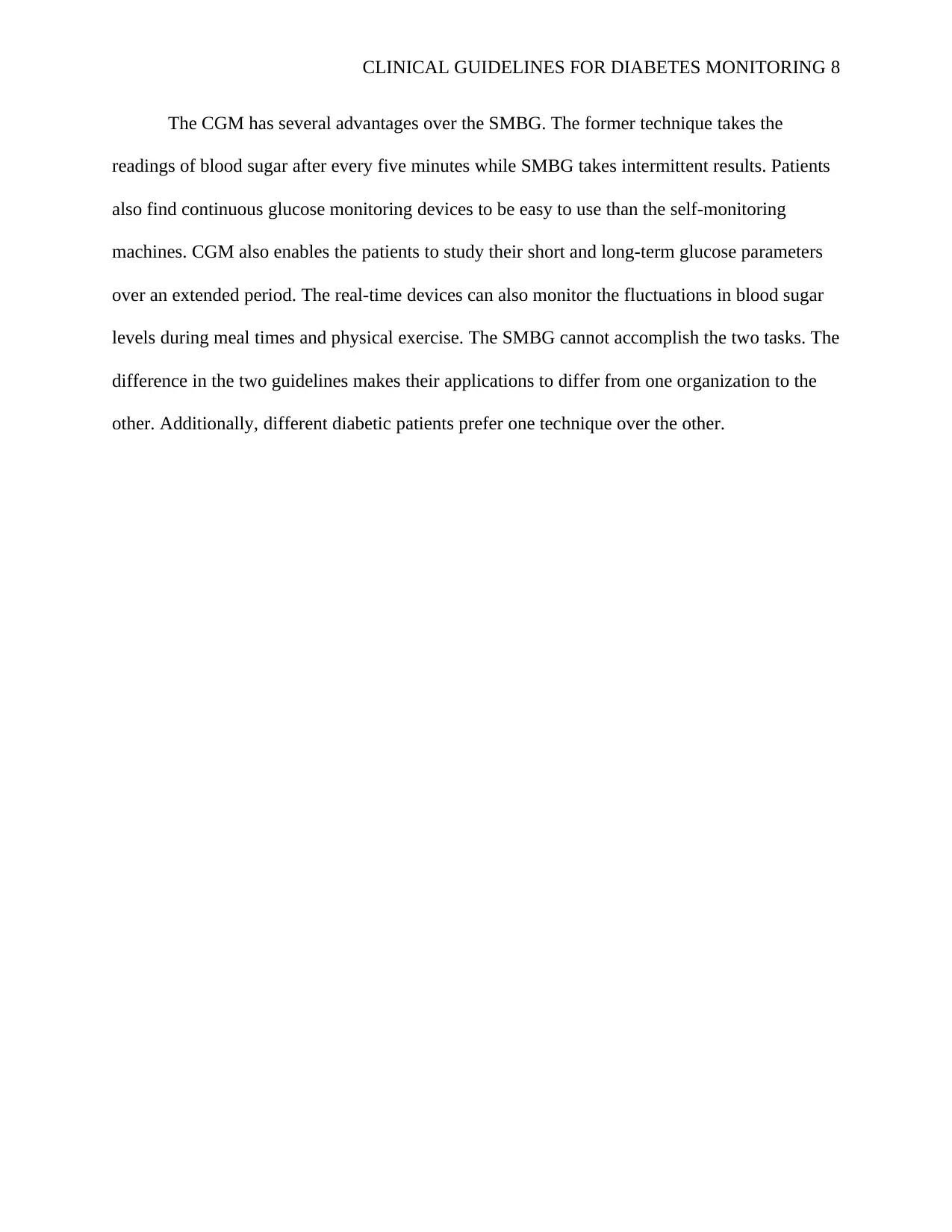
CLINICAL GUIDELINES FOR DIABETES MONITORING 8
The CGM has several advantages over the SMBG. The former technique takes the
readings of blood sugar after every five minutes while SMBG takes intermittent results. Patients
also find continuous glucose monitoring devices to be easy to use than the self-monitoring
machines. CGM also enables the patients to study their short and long-term glucose parameters
over an extended period. The real-time devices can also monitor the fluctuations in blood sugar
levels during meal times and physical exercise. The SMBG cannot accomplish the two tasks. The
difference in the two guidelines makes their applications to differ from one organization to the
other. Additionally, different diabetic patients prefer one technique over the other.
The CGM has several advantages over the SMBG. The former technique takes the
readings of blood sugar after every five minutes while SMBG takes intermittent results. Patients
also find continuous glucose monitoring devices to be easy to use than the self-monitoring
machines. CGM also enables the patients to study their short and long-term glucose parameters
over an extended period. The real-time devices can also monitor the fluctuations in blood sugar
levels during meal times and physical exercise. The SMBG cannot accomplish the two tasks. The
difference in the two guidelines makes their applications to differ from one organization to the
other. Additionally, different diabetic patients prefer one technique over the other.
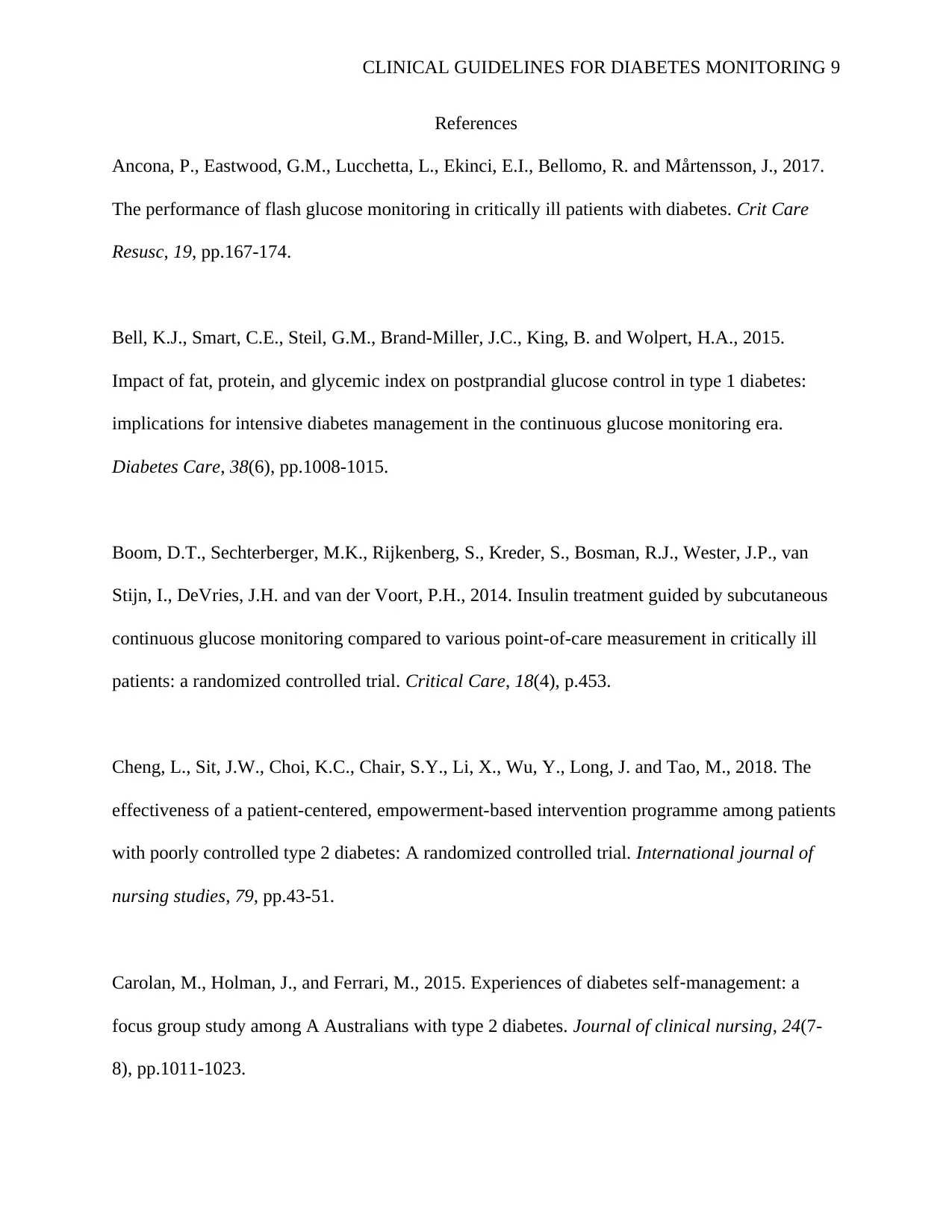
CLINICAL GUIDELINES FOR DIABETES MONITORING 9
References
Ancona, P., Eastwood, G.M., Lucchetta, L., Ekinci, E.I., Bellomo, R. and Mårtensson, J., 2017.
The performance of flash glucose monitoring in critically ill patients with diabetes. Crit Care
Resusc, 19, pp.167-174.
Bell, K.J., Smart, C.E., Steil, G.M., Brand-Miller, J.C., King, B. and Wolpert, H.A., 2015.
Impact of fat, protein, and glycemic index on postprandial glucose control in type 1 diabetes:
implications for intensive diabetes management in the continuous glucose monitoring era.
Diabetes Care, 38(6), pp.1008-1015.
Boom, D.T., Sechterberger, M.K., Rijkenberg, S., Kreder, S., Bosman, R.J., Wester, J.P., van
Stijn, I., DeVries, J.H. and van der Voort, P.H., 2014. Insulin treatment guided by subcutaneous
continuous glucose monitoring compared to various point-of-care measurement in critically ill
patients: a randomized controlled trial. Critical Care, 18(4), p.453.
Cheng, L., Sit, J.W., Choi, K.C., Chair, S.Y., Li, X., Wu, Y., Long, J. and Tao, M., 2018. The
effectiveness of a patient-centered, empowerment-based intervention programme among patients
with poorly controlled type 2 diabetes: A randomized controlled trial. International journal of
nursing studies, 79, pp.43-51.
Carolan, M., Holman, J., and Ferrari, M., 2015. Experiences of diabetes self‐management: a
focus group study among A Australians with type 2 diabetes. Journal of clinical nursing, 24(7-
8), pp.1011-1023.
References
Ancona, P., Eastwood, G.M., Lucchetta, L., Ekinci, E.I., Bellomo, R. and Mårtensson, J., 2017.
The performance of flash glucose monitoring in critically ill patients with diabetes. Crit Care
Resusc, 19, pp.167-174.
Bell, K.J., Smart, C.E., Steil, G.M., Brand-Miller, J.C., King, B. and Wolpert, H.A., 2015.
Impact of fat, protein, and glycemic index on postprandial glucose control in type 1 diabetes:
implications for intensive diabetes management in the continuous glucose monitoring era.
Diabetes Care, 38(6), pp.1008-1015.
Boom, D.T., Sechterberger, M.K., Rijkenberg, S., Kreder, S., Bosman, R.J., Wester, J.P., van
Stijn, I., DeVries, J.H. and van der Voort, P.H., 2014. Insulin treatment guided by subcutaneous
continuous glucose monitoring compared to various point-of-care measurement in critically ill
patients: a randomized controlled trial. Critical Care, 18(4), p.453.
Cheng, L., Sit, J.W., Choi, K.C., Chair, S.Y., Li, X., Wu, Y., Long, J. and Tao, M., 2018. The
effectiveness of a patient-centered, empowerment-based intervention programme among patients
with poorly controlled type 2 diabetes: A randomized controlled trial. International journal of
nursing studies, 79, pp.43-51.
Carolan, M., Holman, J., and Ferrari, M., 2015. Experiences of diabetes self‐management: a
focus group study among A Australians with type 2 diabetes. Journal of clinical nursing, 24(7-
8), pp.1011-1023.
⊘ This is a preview!⊘
Do you want full access?
Subscribe today to unlock all pages.

Trusted by 1+ million students worldwide
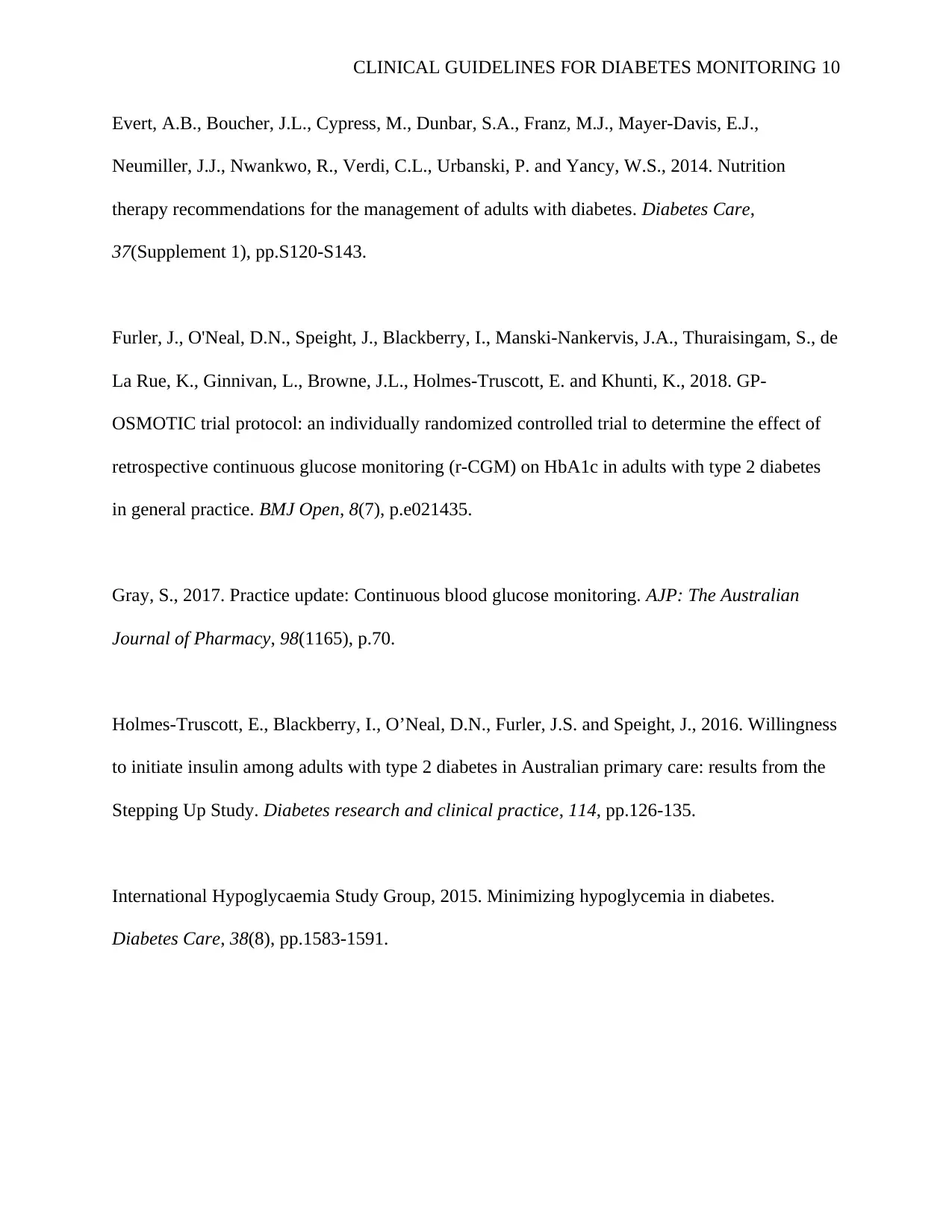
CLINICAL GUIDELINES FOR DIABETES MONITORING 10
Evert, A.B., Boucher, J.L., Cypress, M., Dunbar, S.A., Franz, M.J., Mayer-Davis, E.J.,
Neumiller, J.J., Nwankwo, R., Verdi, C.L., Urbanski, P. and Yancy, W.S., 2014. Nutrition
therapy recommendations for the management of adults with diabetes. Diabetes Care,
37(Supplement 1), pp.S120-S143.
Furler, J., O'Neal, D.N., Speight, J., Blackberry, I., Manski-Nankervis, J.A., Thuraisingam, S., de
La Rue, K., Ginnivan, L., Browne, J.L., Holmes-Truscott, E. and Khunti, K., 2018. GP-
OSMOTIC trial protocol: an individually randomized controlled trial to determine the effect of
retrospective continuous glucose monitoring (r-CGM) on HbA1c in adults with type 2 diabetes
in general practice. BMJ Open, 8(7), p.e021435.
Gray, S., 2017. Practice update: Continuous blood glucose monitoring. AJP: The Australian
Journal of Pharmacy, 98(1165), p.70.
Holmes-Truscott, E., Blackberry, I., O’Neal, D.N., Furler, J.S. and Speight, J., 2016. Willingness
to initiate insulin among adults with type 2 diabetes in Australian primary care: results from the
Stepping Up Study. Diabetes research and clinical practice, 114, pp.126-135.
International Hypoglycaemia Study Group, 2015. Minimizing hypoglycemia in diabetes.
Diabetes Care, 38(8), pp.1583-1591.
Evert, A.B., Boucher, J.L., Cypress, M., Dunbar, S.A., Franz, M.J., Mayer-Davis, E.J.,
Neumiller, J.J., Nwankwo, R., Verdi, C.L., Urbanski, P. and Yancy, W.S., 2014. Nutrition
therapy recommendations for the management of adults with diabetes. Diabetes Care,
37(Supplement 1), pp.S120-S143.
Furler, J., O'Neal, D.N., Speight, J., Blackberry, I., Manski-Nankervis, J.A., Thuraisingam, S., de
La Rue, K., Ginnivan, L., Browne, J.L., Holmes-Truscott, E. and Khunti, K., 2018. GP-
OSMOTIC trial protocol: an individually randomized controlled trial to determine the effect of
retrospective continuous glucose monitoring (r-CGM) on HbA1c in adults with type 2 diabetes
in general practice. BMJ Open, 8(7), p.e021435.
Gray, S., 2017. Practice update: Continuous blood glucose monitoring. AJP: The Australian
Journal of Pharmacy, 98(1165), p.70.
Holmes-Truscott, E., Blackberry, I., O’Neal, D.N., Furler, J.S. and Speight, J., 2016. Willingness
to initiate insulin among adults with type 2 diabetes in Australian primary care: results from the
Stepping Up Study. Diabetes research and clinical practice, 114, pp.126-135.
International Hypoglycaemia Study Group, 2015. Minimizing hypoglycemia in diabetes.
Diabetes Care, 38(8), pp.1583-1591.
Paraphrase This Document
Need a fresh take? Get an instant paraphrase of this document with our AI Paraphraser
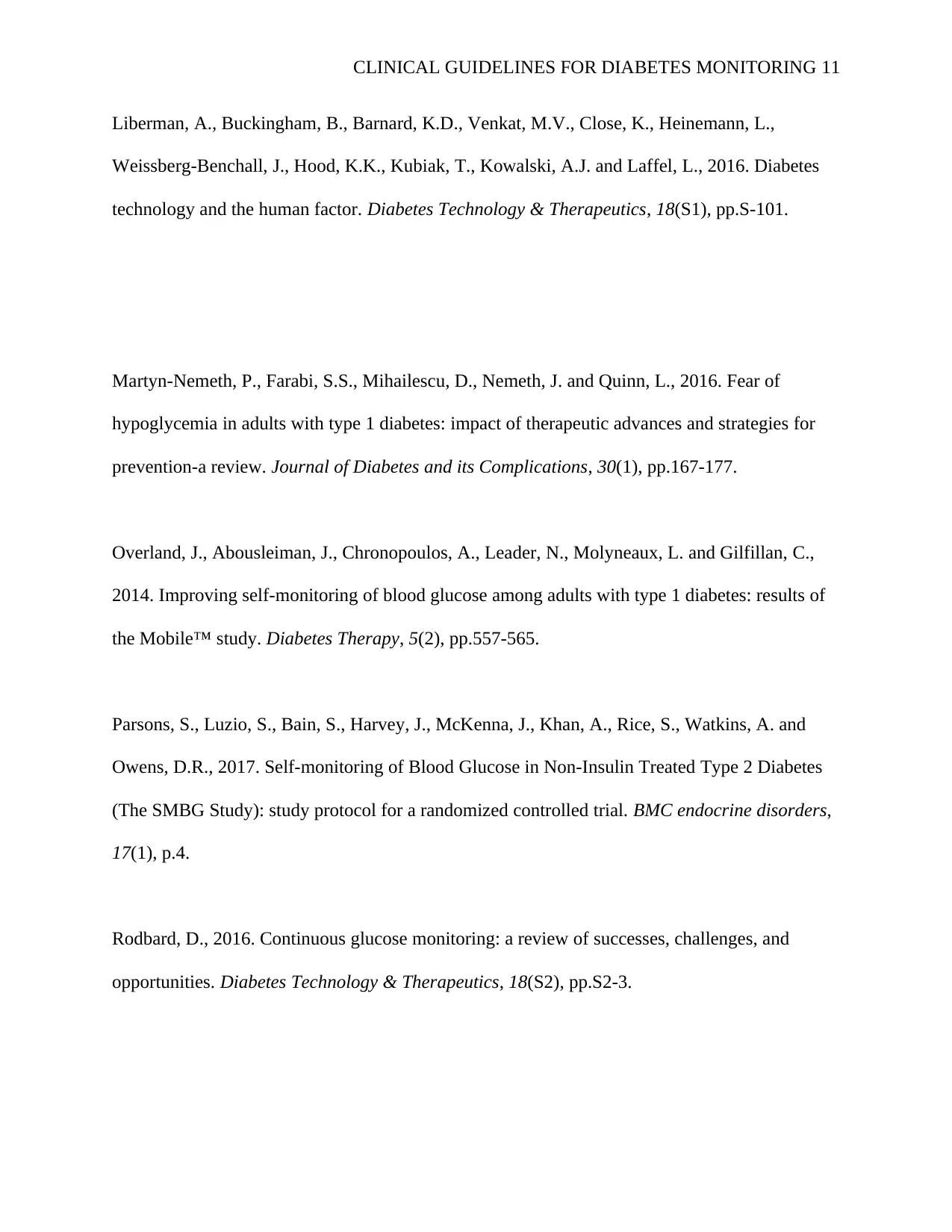
CLINICAL GUIDELINES FOR DIABETES MONITORING 11
Liberman, A., Buckingham, B., Barnard, K.D., Venkat, M.V., Close, K., Heinemann, L.,
Weissberg-Benchall, J., Hood, K.K., Kubiak, T., Kowalski, A.J. and Laffel, L., 2016. Diabetes
technology and the human factor. Diabetes Technology & Therapeutics, 18(S1), pp.S-101.
Martyn-Nemeth, P., Farabi, S.S., Mihailescu, D., Nemeth, J. and Quinn, L., 2016. Fear of
hypoglycemia in adults with type 1 diabetes: impact of therapeutic advances and strategies for
prevention-a review. Journal of Diabetes and its Complications, 30(1), pp.167-177.
Overland, J., Abousleiman, J., Chronopoulos, A., Leader, N., Molyneaux, L. and Gilfillan, C.,
2014. Improving self-monitoring of blood glucose among adults with type 1 diabetes: results of
the Mobile™ study. Diabetes Therapy, 5(2), pp.557-565.
Parsons, S., Luzio, S., Bain, S., Harvey, J., McKenna, J., Khan, A., Rice, S., Watkins, A. and
Owens, D.R., 2017. Self-monitoring of Blood Glucose in Non-Insulin Treated Type 2 Diabetes
(The SMBG Study): study protocol for a randomized controlled trial. BMC endocrine disorders,
17(1), p.4.
Rodbard, D., 2016. Continuous glucose monitoring: a review of successes, challenges, and
opportunities. Diabetes Technology & Therapeutics, 18(S2), pp.S2-3.
Liberman, A., Buckingham, B., Barnard, K.D., Venkat, M.V., Close, K., Heinemann, L.,
Weissberg-Benchall, J., Hood, K.K., Kubiak, T., Kowalski, A.J. and Laffel, L., 2016. Diabetes
technology and the human factor. Diabetes Technology & Therapeutics, 18(S1), pp.S-101.
Martyn-Nemeth, P., Farabi, S.S., Mihailescu, D., Nemeth, J. and Quinn, L., 2016. Fear of
hypoglycemia in adults with type 1 diabetes: impact of therapeutic advances and strategies for
prevention-a review. Journal of Diabetes and its Complications, 30(1), pp.167-177.
Overland, J., Abousleiman, J., Chronopoulos, A., Leader, N., Molyneaux, L. and Gilfillan, C.,
2014. Improving self-monitoring of blood glucose among adults with type 1 diabetes: results of
the Mobile™ study. Diabetes Therapy, 5(2), pp.557-565.
Parsons, S., Luzio, S., Bain, S., Harvey, J., McKenna, J., Khan, A., Rice, S., Watkins, A. and
Owens, D.R., 2017. Self-monitoring of Blood Glucose in Non-Insulin Treated Type 2 Diabetes
(The SMBG Study): study protocol for a randomized controlled trial. BMC endocrine disorders,
17(1), p.4.
Rodbard, D., 2016. Continuous glucose monitoring: a review of successes, challenges, and
opportunities. Diabetes Technology & Therapeutics, 18(S2), pp.S2-3.
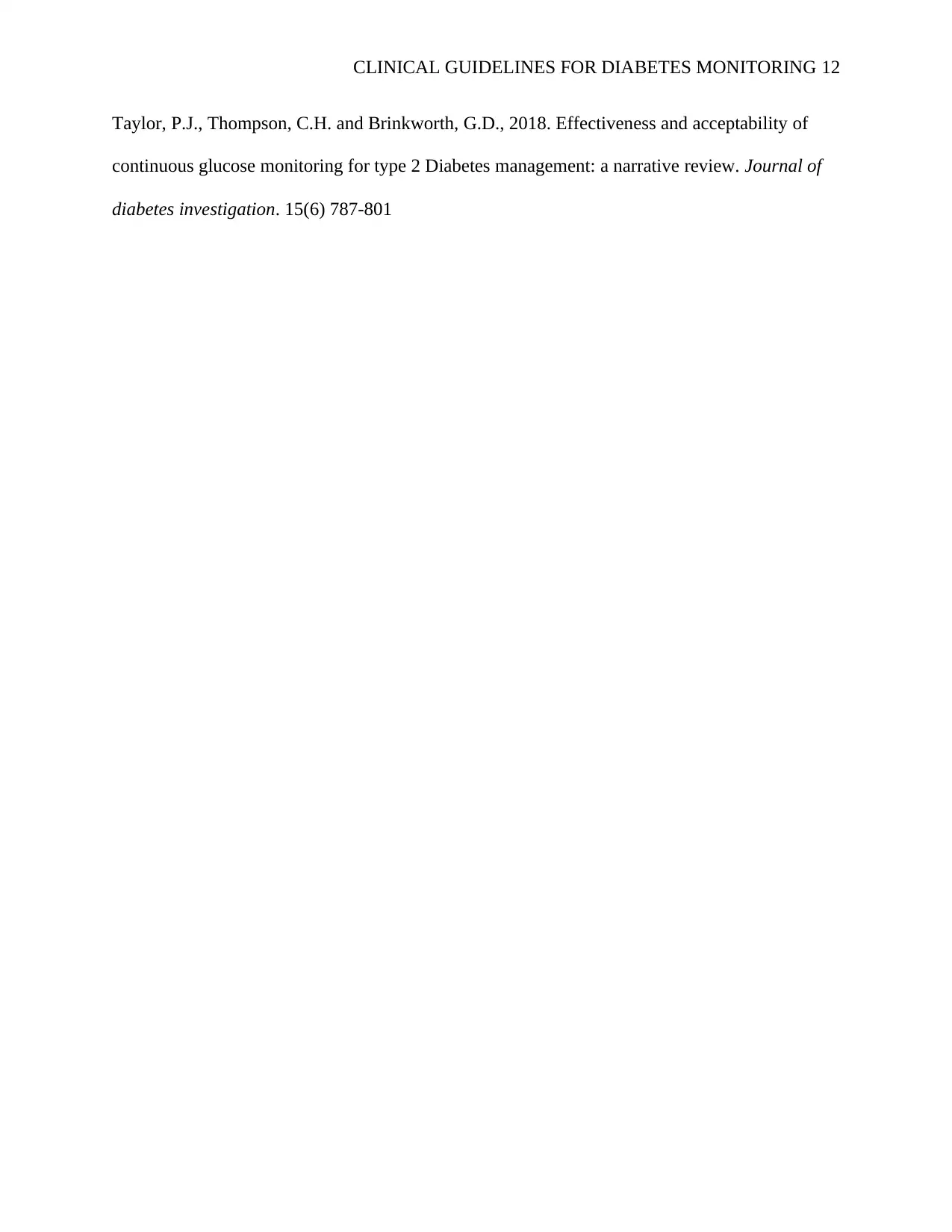
CLINICAL GUIDELINES FOR DIABETES MONITORING 12
Taylor, P.J., Thompson, C.H. and Brinkworth, G.D., 2018. Effectiveness and acceptability of
continuous glucose monitoring for type 2 Diabetes management: a narrative review. Journal of
diabetes investigation. 15(6) 787-801
Taylor, P.J., Thompson, C.H. and Brinkworth, G.D., 2018. Effectiveness and acceptability of
continuous glucose monitoring for type 2 Diabetes management: a narrative review. Journal of
diabetes investigation. 15(6) 787-801
⊘ This is a preview!⊘
Do you want full access?
Subscribe today to unlock all pages.

Trusted by 1+ million students worldwide
1 out of 18
Your All-in-One AI-Powered Toolkit for Academic Success.
+13062052269
info@desklib.com
Available 24*7 on WhatsApp / Email
![[object Object]](/_next/static/media/star-bottom.7253800d.svg)
Unlock your academic potential
Copyright © 2020–2025 A2Z Services. All Rights Reserved. Developed and managed by ZUCOL.
